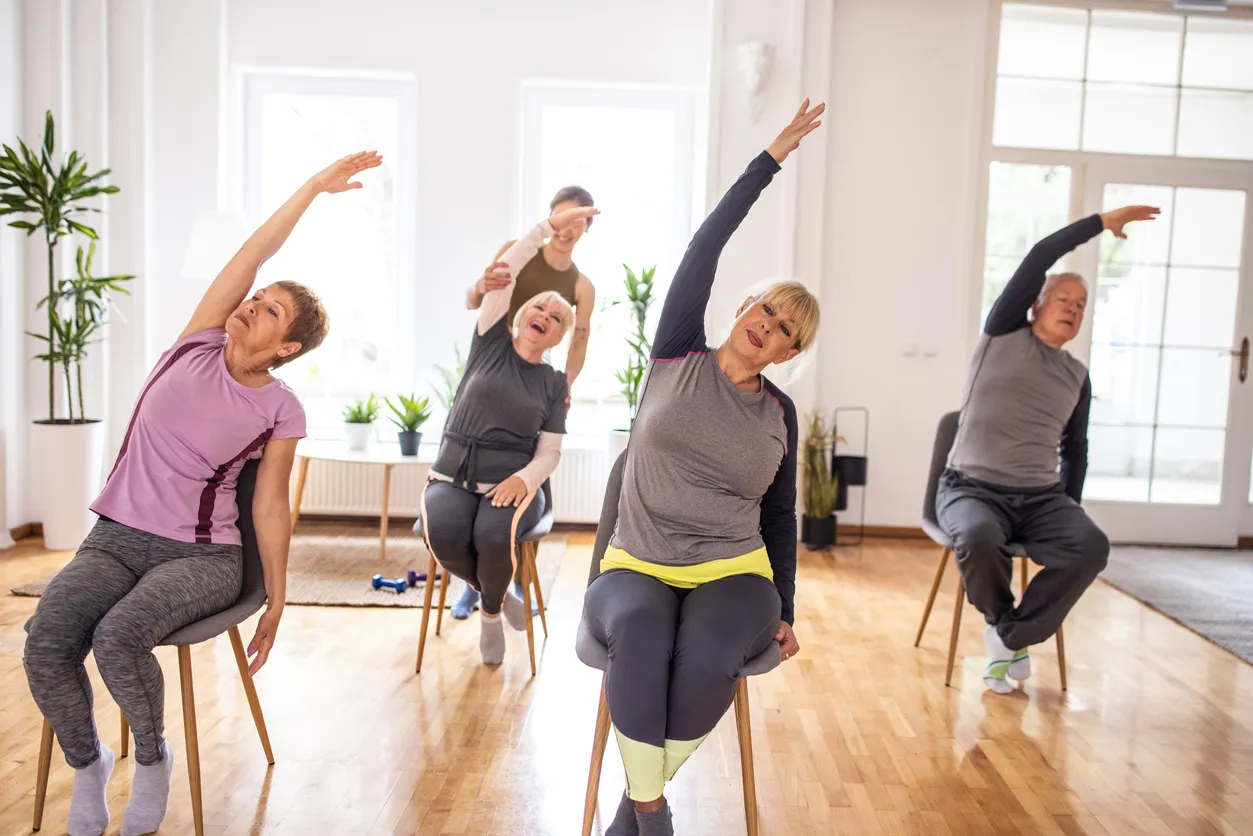Staying active is one of the best ways to maintain independence, boost energy, and enhance overall well-being as you age. At Fields Senior Living at Weatherly Inn, we believe movement is medicine and encourage our residents to engage in safe, enjoyable exercise routines. Whether you want to build strength, improve balance, or stay mobile, the right fitness routine can make all the difference.
In this guide, we’ll explore the best exercises for seniors, their benefits, and a few workouts to avoid to keep your joints and muscles in optimal shape.
Why Exercise Is Essential for Seniors
Exercise isn’t just about staying fit—it’s about maintaining the freedom to live on your terms. Regular movement profoundly affects the body and mind, making daily activities easier and keeping chronic illnesses at bay.
1. Exercise Promotes Independence
Staying physically active helps preserve muscle strength, flexibility, and coordination, which are key for completing everyday tasks—like getting out of bed, walking up stairs, or carrying groceries. The more you move, the more confident and independent you’ll feel.
2. Movement Improves Balance and Reduces Fall Risk
Falls are one of the leading causes of injury in older adults, but balance-focused exercises like Tai Chi, yoga, and water aerobics can significantly lower this risk. These activities strengthen stabilizing muscles and improve coordination, making movements steadier and safer.
3. Exercise Boosts Energy and Reduces Fatigue
Regular physical activity enhances blood circulation, oxygen flow, and overall stamina. Seniors who incorporate movement into their daily routines often experience better sleep, increased energy levels, and overall well-being.
4. Physical Activity Helps Manage Chronic Conditions
Exercise is a natural way to prevent and manage chronic diseases like heart disease, diabetes, osteoporosis, and arthritis. Low-impact workouts keep the body strong, support heart health, and even help regulate blood sugar levels.
5. Exercise Enhances Cognitive Function and Mental Health
Physical activity isn’t just for the body—it’s also essential for the brain. Studies have shown that seniors who stay active have a lower risk of dementia, sharper memory, and better cognitive function. Movement also releases endorphins, which can improve mood and reduce symptoms of depression and anxiety.
The 7 Best Exercises for Seniors
When choosing an exercise routine, it’s important to select activities that are safe, effective, and enjoyable. Here are the top seven exercises recommended for older adults:
1. Chair Yoga – Gentle, Low-Impact Stretching
You don’t have to get on the floor to enjoy the benefits of yoga! Chair yoga is a gentle way for seniors to improve flexibility, strengthen muscles, and relax—all while seated or using a chair for support. Perfect for those who want to stay active without straining their joints or risking injury.
Benefits: Increases flexibility, improves posture, and reduces stress.
2. Water Aerobics – Low-Impact Cardiovascular Exercise
Exercising in water is easy on the joints while offering resistance to build muscle strength. Water aerobics enhances cardiovascular health and mobility and is a fun, social activity.
Benefits: Supports heart health, strengthens muscles, and reduces joint pain.
3. Pilates – Core Strength and Stability
Pilates focuses on controlled movements that enhance core strength, stability, and posture. It’s particularly beneficial for seniors looking to improve balance and prevent falls.
Benefits: Strengthens core muscles, improves coordination, and reduces back pain.
4. Walking – The Simplest Yet Most Effective Exercise
Walking is a low-impact, full-body workout that boosts heart health, strengthens leg muscles, and supports mental well-being. Whether it’s a stroll around the neighborhood or a brisk walk in the park, every step counts!
Benefits: Improves circulation, strengthens bones, and enhances mood.
5. Resistance Band Training – Strength Without the Strain
Using resistance bands is an excellent way to maintain muscle mass and joint flexibility without the risk of heavy weightlifting. Resistance exercises can be done seated or standing, making them adaptable for different fitness levels.
Benefits: Builds muscle strength, enhances flexibility and protects joints.
6. Tai Chi – The Art of Balance and Coordination
Often referred to as “meditation in motion,” Tai Chi involves slow, fluid movements that promote balance, flexibility, and mental clarity. It’s one of the best exercises for preventing falls.
Benefits: Enhances coordination, reduces stress, and improves stability.
7. Strength Training – Maintain Muscle and Bone Density
Lightweight strength training is crucial for maintaining muscle mass, supporting bone density, and preventing frailty. Simple movements like bicep curls, leg lifts, and body-weight squats can make a big difference.
Benefits: Preserve bone health, boost metabolism, and strengthen muscles.
Exercises Seniors Should Avoid
While exercise is beneficial, some workouts may be too high-impact or unsafe for older adults. Here are a few exercises to approach with caution:
- Running or Jumping Movements – High-impact exercises can strain the joints and increase the risk of falls.
- Heavy Weightlifting – Lifting excessive weights can lead to joint pain and injuries. Stick to light resistance exercises.
- Crunches or Sit-Ups – These exercises can put pressure on the spine and neck, increasing the risk of injury.
- Deep Squats and Lunges – These moves can be hard on the knees and should be modified or avoided.
Instead: Opt for low-impact alternatives like seated exercises, supported squats, and gentle stretching to stay active without discomfort.
How to Get Started with an Exercise Routine
Starting a new fitness routine can feel overwhelming, but following these simple steps can make the process enjoyable and sustainable:
- Start Slow – Begin with short, gentle movements and gradually increase duration and intensity.
- Listen to Your Body – Modify the movement or stop if something feels painful or uncomfortable.
- Stay Consistent – Exercise regularly to experience long-term benefits, even if just a short daily walk.
- Incorporate Variety – Mixing different exercises keeps workouts interesting and targets different muscle groups.
- Consult a Professional – Speak with a doctor or physical therapist before starting any new routine to ensure safety.
Staying Active at Fields Senior Living at Weatherly Inn
At Fields Senior Living at Weatherly Inn in Medford, OR, we believe staying active is a key part of aging. Our community offers a variety of wellness programs designed specifically for seniors, including:
- Group Fitness Classes – Chair yoga, Tai Chi, and low-impact aerobics for social and physical engagement.
- Walking Clubs – Explore beautiful paths while staying active and connecting with fellow residents.
- Personalized Exercise Plans – Our expert staff can help create routines tailored to individual fitness levels and goals.
No matter where you are in your fitness journey, we’re here to support you in living a vibrant, active, and fulfilling life.
Frequently Asked Questions (FAQs)
Q: How often should seniors exercise?
A: Seniors should aim for at least 150 minutes of moderate-intensity exercise per week and strength and balance exercises twice a week.
Q: Can I exercise if I have arthritis?
A: Yes! Low-impact exercises like swimming, yoga, and resistance band training can help reduce stiffness and improve joint function.
Q: Is it safe to start exercising if I’ve been inactive for years?
A: Absolutely! Start with gentle movements and gradually build up your strength. Always check with a healthcare professional before beginning a new routine.
Q: What’s the best exercise for fall prevention?
A: Tai Chi, yoga, and balance exercises are excellent for improving stability and reducing the risk of falls.
Q: Do I need special equipment to start exercising?
A: No! Many exercises, like walking, body-weight movements, and stretching, require no equipment.



